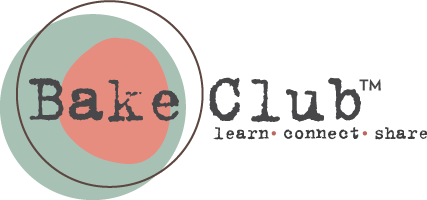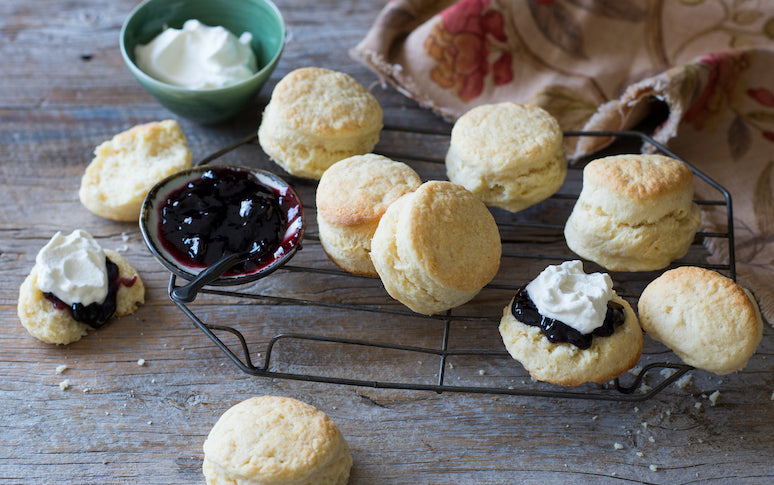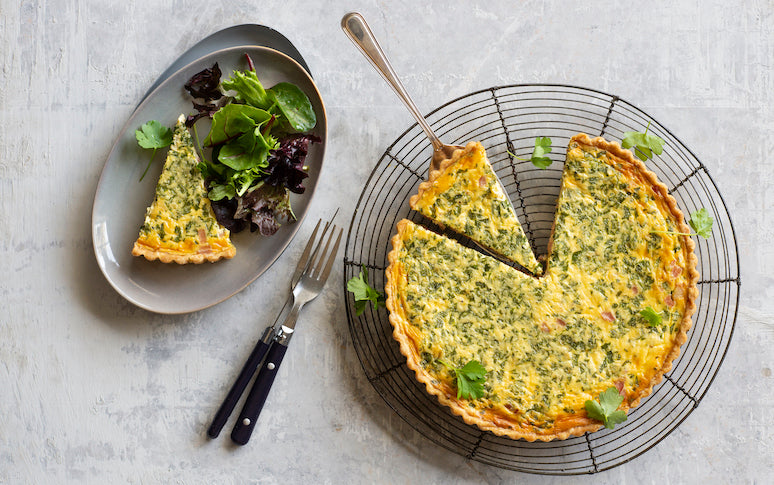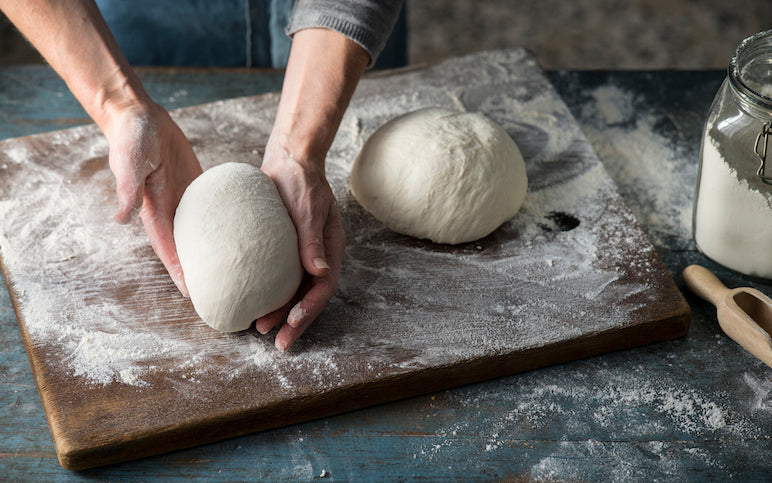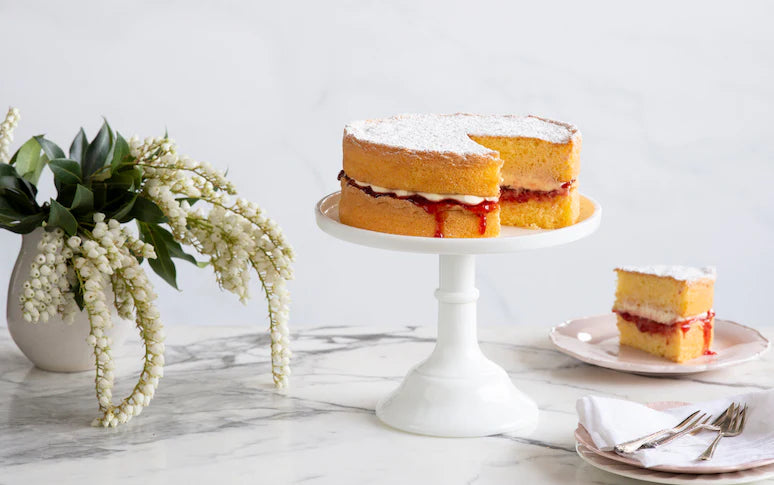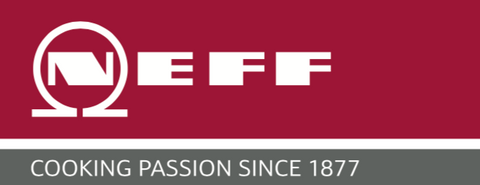- home
- Products
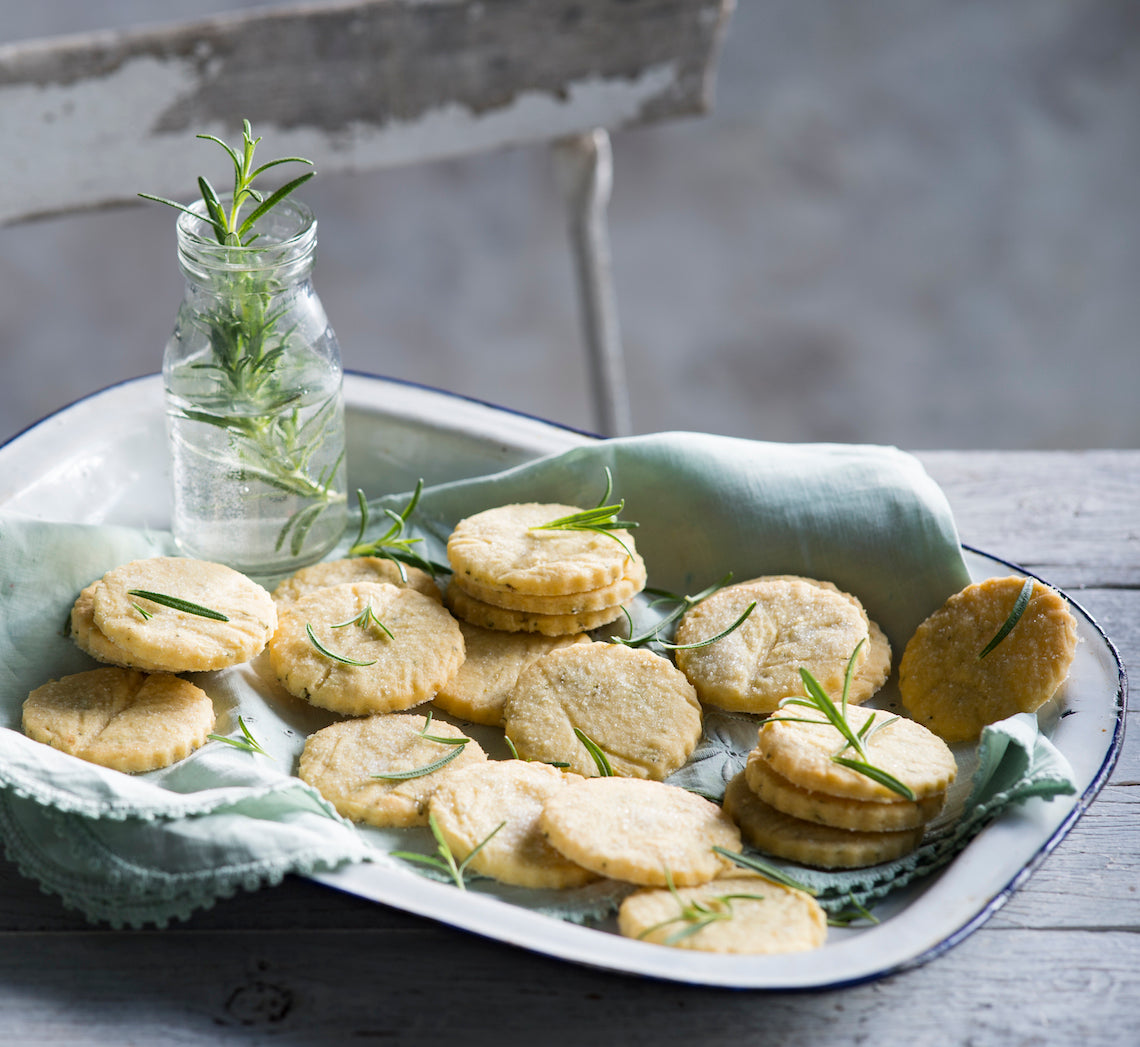
Prep 30min (+ 1hr chilling time)Bake 15-20min (per batch)Makes about 80
Along with lemon, these melt-in-the-mouth biscuits are scented with rosemary’s distinct, yet subtle, earthy and slightly sweet flavour. The clever imprinting of rosemary sprigs of the dough gives a gorgeous finish to these sweet, buttery mouthfuls.
Ingredients
250g (9oz) salted butter, cubed and softened slightly
165g (¾ cup/5¾oz) granulated white sugar, plus 2 tablespoons extra to sprinkle
1 egg yolk
335g (2¼ cups/8¼oz) plain flour
1½ tablespoons finely chopped fresh rosemary (see Baker’s Tips)
1 lemon, rind finely grated
Small rosemary sprigs, to imprint biscuits
Method
- Line 3 large oven trays with baking paper.
- Use an electric mixer with a paddle attachment to beat the butter and sugar for about 1 minute or until starting to become pale and creamy but not too aerated (do not over beat). Beat in the egg yolk, rosemary and lemon until just combined.
- Add the flour to the butter mixture and beat on low speed until just combined and a soft dough forms.
- Divide the dough in half and shape each portion into a disc about 2cm/¾in thick. Wrap separately in plastic wrap and place in the fridge for 30 minutes to chill.
- Use a lightly floured rolling pin to roll a portion of dough out on a lightly floured bench top until 4mm/⅛in thick. Arrange the rosemary sprigs over the dough and lightly roll over with the rolling pin to imprint. Remove the rosemary sprigs and reserve. Use a 4.5cm/1¾in fluted round biscuit cutter to cut the dough into rounds and place on the lined trays, re-rolling, imprinting and cutting out any off cuts. Repeat with the remaining portion of dough. Sprinkle the biscuits liberally with the extra sugar.
- Place the trays in the fridge for 30 minutes to chill.
- Preheat oven to 170°C/340°F (150°C/300°F fan-forced)
- Bake 2 trays of the biscuits in preheated oven for 15-20 minutes, swapping the trays around half way through baking, or until pale golden and cooked through. Cool on the trays. Repeat with the remaining tray of biscuits, baking in the centre of the oven.
Baker's Tips
- Chopping the rosemary with a pinch of sugar will help bring out its aromatic flavours.
- These biscuits will store in an airtight container at room temperature for up to week.
This recipe is from Anneka's SBS Food online column Bakeproof: Christmas Baking with Fresh Herbs. Click here for more Bakeproof columns and recipes.
Photography by Alan Benson.
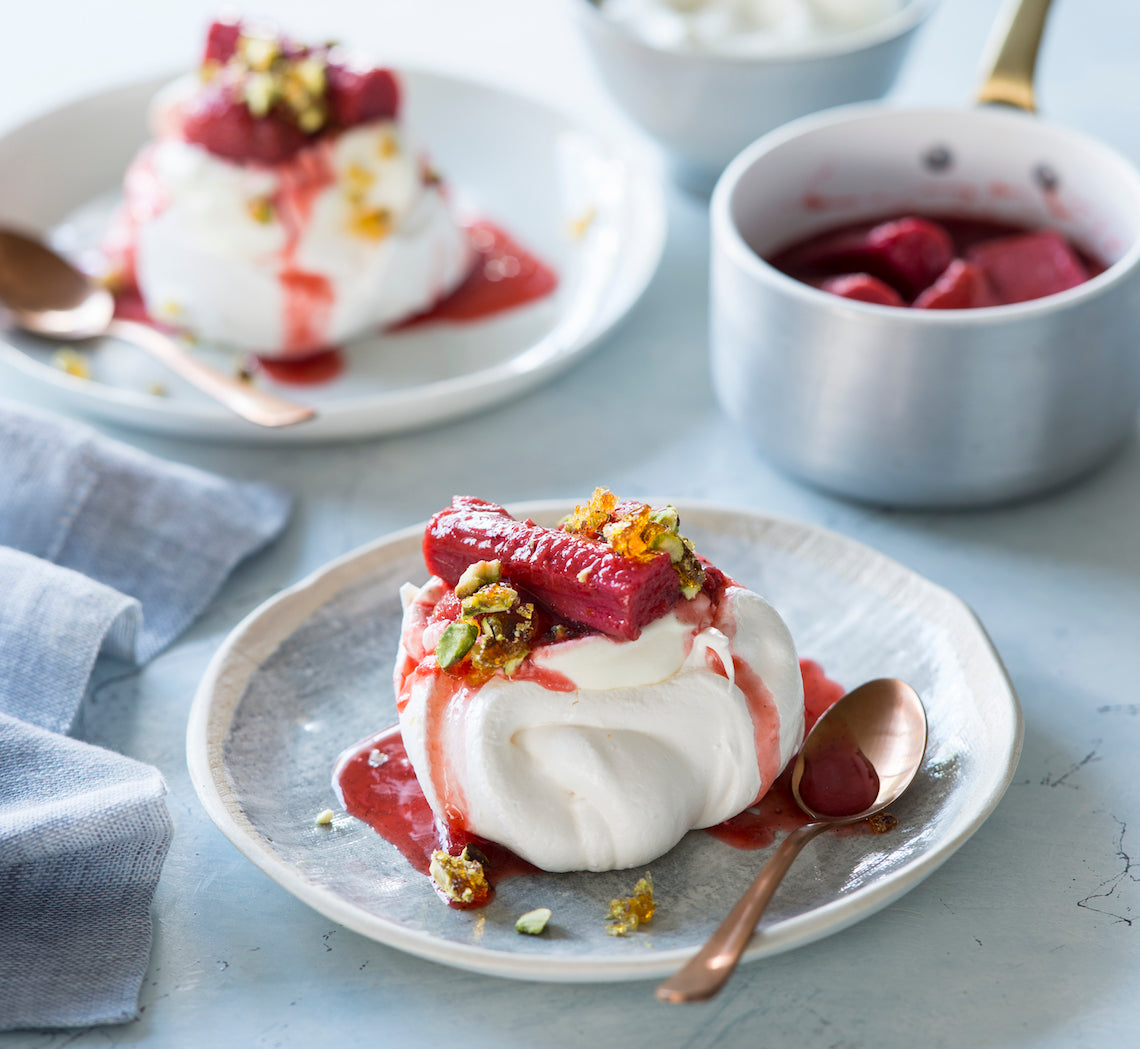
Prep 1hr (+2hr cooling time)
Bake 1hr 35minMakes 8 serves
Delicately flavoured with rosewater, these individual pavlovas make a divine create-your-own dessert. Those who prefer a slightly more casual approach to assembly can opt for an Eaton mess. Simply crush the pavlovas and layer the individual elements in a glass instead!
Ingredients
lime wedges, to serve
Rosewater pavlovas
3 egg whites, at room temperature
165g (¾ cup) caster sugar
2 teaspoons cornflour, sifted
2 teaspoons rosewater
Vanilla-roasted red fruits
500g trimmed rhubarb (about 2 bunches), cut into 6 cm lengths
2 x 250g punnets small strawberries, hulled
2 vanilla beans, split lengthways
150g (⅔ cup) caster sugar
Yoghurt cream
125ml (½ cup) thickened cream, whipped to firm peaks
130g (½ cup) thick Greek-style natural yoghurt
Toffee pistachios
110g (½ cup) caster sugar
60ml (¼ cup) water
75g unsalted pistachio kernels, toasted
Method
- To make the rosewater pavlovas, place the oven rack in the lower third of the oven and preheat it to 110°C. Line an oven tray with non-stick baking paper. Use an electric mixer with a whisk attachment to whisk the egg whites in a large bowl on medium-high speed until soft peaks form. With the motor running, add the sugar a spoonful at a time, whisking well after each addition, until all the sugar has dissolved and the mixture is very thick and glossy (this will take 4-5 minutes). Add the cornflour and rosewater and whisk to combine. Use a spatula to stir the meringue mixture to ‘loosen’ it slightly (this will get rid of any excess air in the mixture and give it a smoother, less ‘foamy’ texture). Use two metal tablespoons to spoon 8 ovals of the meringue mixture on to the lined tray and use the back of a spoon to make in an indent in the centre of each. Bake in the lower third of the preheated oven for 1 hour 15 minutes, until the meringue is crisp and hard to touch, but not coloured. Turn off the oven, leave the door slightly ajar and cool it completely in the oven (this will take about 2 hours).
- To make the toffee pistachios, line an oven tray with non-stick baking paper. Combine the caster sugar and water in a small saucepan and use a wooden spoon to stir over low heat until the sugar dissolves. Increase the heat to medium and bring to the boil. Boil for 8-10 minutes, brushing down the side of the pan with a pastry brush dipped in water to dissolve any sugar crystals, until the mixture turns a deep caramel. Pour immediately onto the lined tray and then sprinkle with the pistachios. Lightly tap the tray 2-3 times on the bench top to settle the pistachios into the toffee and then set aside to cool completely (this will take about 30 minutes). When cool, use the end of a rolling pin to pound the toffee into coarse chunks.
- To make the vanilla-roasted red fruits, preheat the oven to 200°C (180°C fan-forced). Rinse the rhubarb and shake off any excess water. Place in a bowl with the strawberries and sugar. Use a small sharp knife to scrape the seeds from the vanilla bean. Add the bean and the seeds to the rhubarb mixture and toss to combine. Transfer to an ovenproof dish just large enough to hold the fruit in a single layer and cover with foil. Bake in preheated oven for 18-20 minutes or until the rhubarb is just tender and still holding its shape. Remove the foil and set aside to cool.
- To make the yoghurt cream, fold together the whipped cream and yoghurt.
- To serve, place the pavlovas, toffee pistachios, roasted fruit, yoghurt cream and lime wedges in the centre of the table for guests to assemble their own dessert.
Baker's Tips
- The rosewater pavlovas will keep in an airtight container at room temperature for up to 1 week.
- The vanilla-roasted red fruit will keep in an airtight container in the fridge for up to 3 days. Serve at room temperature.
- The toffee pistachios will keep in a sealed jar or airtight container at room temperature for up to 1 month. You may have to pound again to break up before serving.
Photography by Alan Benson. Styling by Jane Hann.
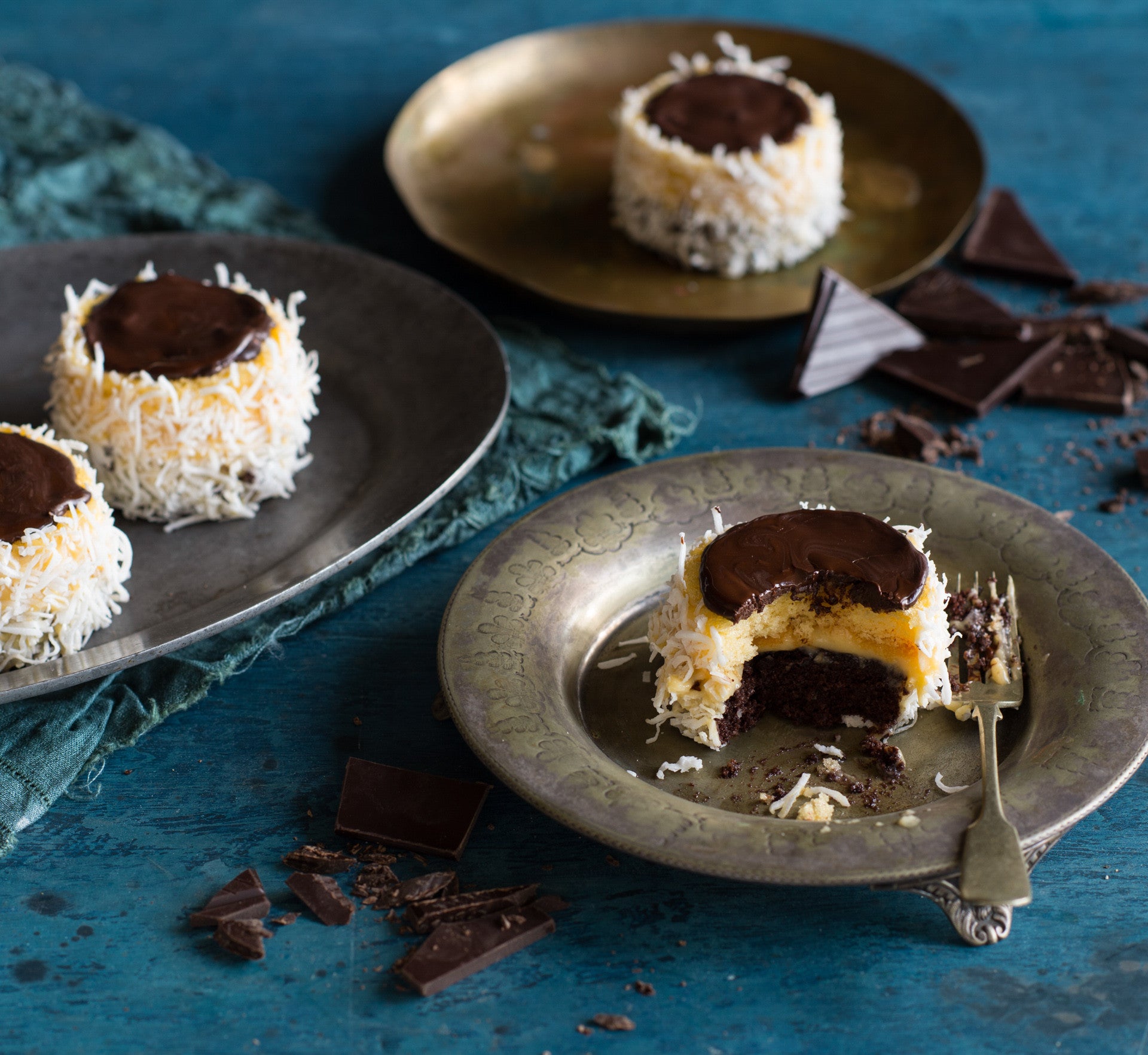
Prep 40min (+20min cooling and 2.5hr chilling)Bake 15minMakes 6 serves
These little layered cakes are the sweetest hats you'll find. Made up of custard cream and a chocolate topping they are covered in shredded coconut for a little texture but you can also use nuts as well, if you have them handy. They are best served chilled and if you aren't much for a dessert fork, then eating these with your hands like a cupcake is absolutely acceptable!
Ingredients
- 100g (1½ cups) shredded coconut, to coat
Sponge Layers
- melted butter, to grease
- 4 eggs, at room temperature
- 165g (¾ cup) caster sugar
- 2 tablespoons boiling water
- 2 tablespoons vegetable oil
- 100g (⅔ cup) self-raising flour, sifted
- 2 tablespoons cocoa powder mixed to a paste with 60 ml (¼ cup) boiling water and cooled
Custard cream
- 1 tablespoon cornflour
- 1 tablespoon custard powder
- 2 tablespoons caster sugar
- 200ml milk
- 20g butter, cubed
- 1 egg yolk
- 1½ teaspoons natural vanilla essence or extract
Chocolate glaze
- 50g dark chocolate, chopped
- 2 teaspoons vegetable oil
Method
- To make the custard cream, sift together the cornflour and custard powder into a small saucepan. Add the sugar and then use a balloon whisk to gradually stir in the milk. Place the saucepan over a medium heat and cook, stirring frequently, until the mixture boils and thickens. Remove from the heat and stir in the butter, egg yolk and vanilla until well combined. Pour into a medium bowl, cover the surface of the custard directly with a piece of plastic wrap and set aside to cool (this will take about 2 hours).
- To make the sponge layers, preheat oven to 180°C (160°C fan-forced). Brush two 16 x 26 cm shallow cake tins with a little melted butter to lightly grease and then line the base and two long sides of each with one piece of non-stick baking paper.
- Use an electric mixer with a whisk attachment on high speed to whisk the eggs and sugar in a large bowl until the mixture is very thick and pale (this will take 5-8 minutes). Lift the whisk out of the mixture and draw a figure eight, if the trail stays on the surface long enough for you to finish drawing then the mixture is ready. If not, continue to whisk for a further minutes and then test again.
- Combine the boiling water and oil. Sift the flour over the egg mixture. Immediately pour the warm water and oil mixture down the side of the bowl and use a spatula to fold until just evenly combined (be careful not to overmix).
- Pour half of the mixture into one of the prepared cake tins. Add the cocoa paste to the mixture still in the bowl and fold together until just combined. Pour into the second cake tin. Gently tap the tins on the bench top three times to settle the mixture. Bake in preheated oven for 12-15 minutes or until the cakes spring back when lightly touched in the centre and start pulling away from the sides of the tins. Stand the cakes in the tins for 2 minutes before turning onto a wire racks to cool completely.
- To assemble, use a 6 cm round cutter to cut each of the Sponge cakes into 6 rounds. Place the round cutter over a chocolate sponge. Top the chocolate sponge round with about 1 tbsp of the Custard cream and then cover with around of plain sponge. Remove the pastry cutter. Repeat with the remaining chocolate and plain sponge rounds and 1 tbsp of Custard cream for each cake to make 6 layered cakes in total. Spread the sides of the cakes with the remaining Custard cream. Roll the sides of the cakes in the coconut to coat and place on a serving plate. Place in the fridge while making the Chocolate glaze.
- Place the chocolate and oil in a heatproof bowl. Place over a saucepan of simmering water, stirring occasionally, until melted and smooth. Carefully spread about 1 tsp of the Chocolate glaze over the tops of each of the cakes to cover. Return the cakes to the fridge for 30 minutes or until the Chocolate glaze is set. Serve chilled.
Baker's Tips
These cakes will keep in an airtight container in the fridge for up to 2 days.This recipe is from Anneka's SBS Food online column, Bakeproof: Bosnian Baking.
CLICK HERE for more Bakeproof recipes.
Photography by Alan Benson.
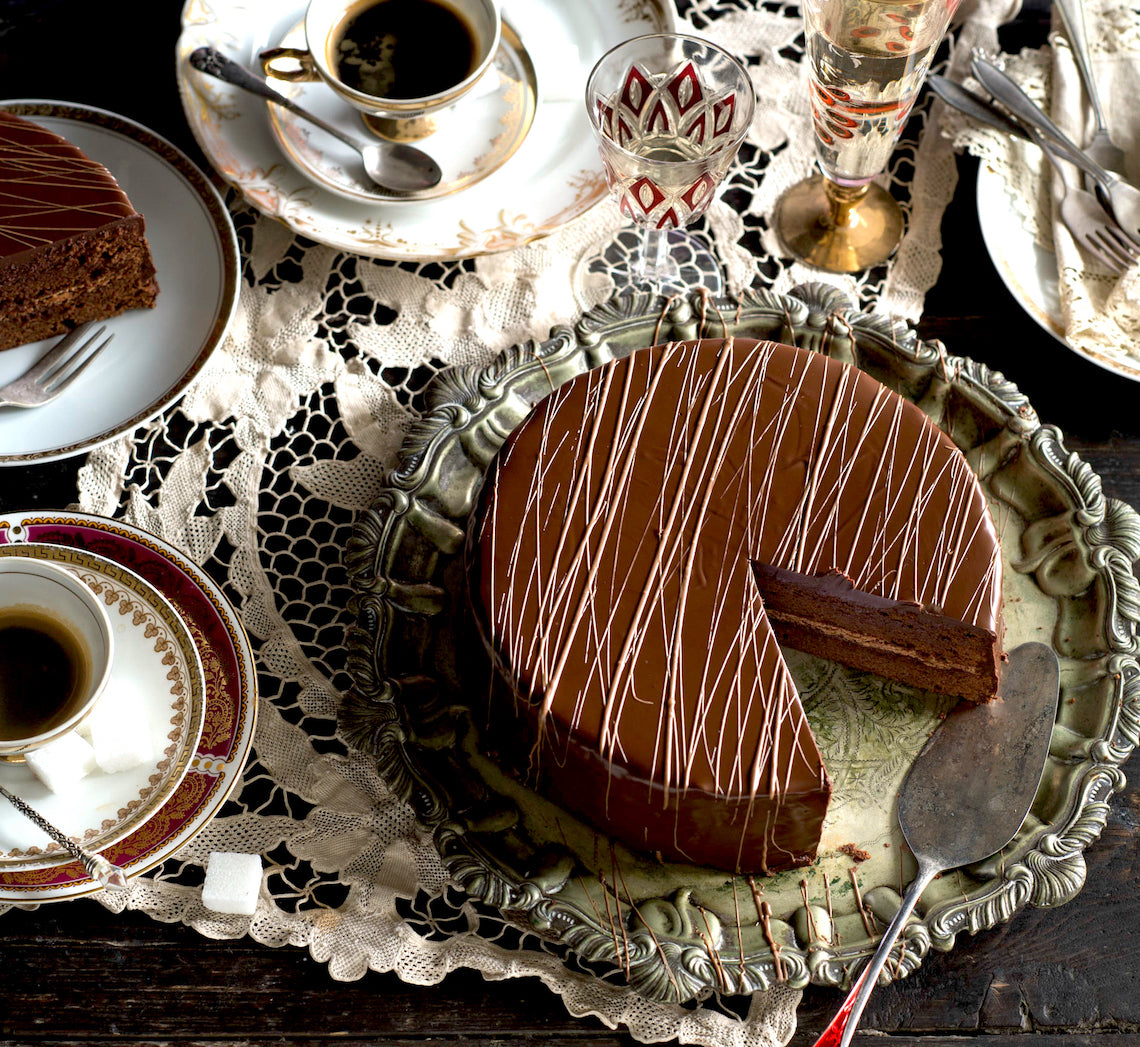
Prep 40min (+1hr cooling and 2hr standing time)Bake 30minMakes 10-12 serves
Possibly the most famous cake in the world, and certainly the pride of Austria, Sacher Torte was created by Franz Sacher, a 16-year-old apprentice stepping in for an ill head chef, to impress the guests of Prince Wenzel von Metternich. And as they say, the rest is now cuisine history. This elegant, rich and enticing cake is now loved the world over.
Ingredients
Melted butter, to grease
125g unsalted butter, softened
125g (1 cup) icing sugar, sifted
1½ teaspoons natural vanilla essence or extract
6 eggs, at room temperature, separated
175g good-quality dark chocolate (54% cocoa), chopped, melted and cooled to room temperature
110g (¾ cup) plain flour
110g (½ cup) caster sugar
85g (¼ cup) apricot jam, warmed and sieved
40g good-quality milk chocolate, melted, to decorate
Thick or whipped cream, to serve
Chocolate Glaze
300g good-quality dark chocolate (54% cocoa)
60g butter, cubed
Method
- Preheat oven to 180°C (160°C fan-forced). Brush 2 x shallow 20cm round cake tins with melted butter to grease and line the bases with rounds of non-stick baking paper.
- Use an electric mixer to beat the butter, icing sugar and vanilla until pale and creamy. Add the egg yolks and beat until well combined and creamy. Beat in the cooled melted chocolate until well combined. Use a large metal spoon or spatula to fold in the flour until just combined.
- Use an electric mixer with a whisk attachment to whisk the egg whites in a large clean, dry bowl until soft peaks form. Add the caster sugar and whisk on medium-high speed until thick and glossy and all the sugar has dissolved (see Baker’s tip). Add half the egg white mixture to the chocolate mixture and use a large metal spoon or spatula to fold in to ‘loosen’ the mixture. Add the remaining egg white mixture and fold until just evenly combined.
- Divide the mixture evenly between the tins and use the back of a spoon to smooth the surface. Bake in preheated oven for 30 minutes or until a skewer inserted into the centre of the cakes comes out clean. Stand in the tins for 10 minutes before turning onto a wire rack to cool (this will take about 1 hour).
- Once cool, spread one cake layer with the warmed sieved jam and then top with the second layer, bottom side up. Place the cake on a wire rack over a tray and set aside while making the chocolate glaze.
- To make the chocolate glaze, combine the chocolate and butter in a heatproof bowl and place over a saucepan of barely simmering water (make sure the base of the bowl doesn’t touch the water). Stir occasionally until just melted and combined. Use a plate knife to spread a little of the glaze over the outside of the cake to form a ‘crumb coat’ and to even the surface. Place in the fridge for 20 minutes or until set. Remove from the fridge and carefully pour over the rest of the glaze, allowing it to run down the sides of the cake to coat evenly. Tap the cake, still on the rack, gently on the tray to remove any air bubbles and to settle the glaze. Use a fork to drizzle the milk chocolate over the top of the cake to decorate. Set aside for 2 hours or until the glaze sets. Serve cut into small wedges with cream.
Baker’s Tips
- To test if all the sugar has dissolved, rub a little of the egg white and sugar between two fingers – you will be able to feel if there is still undissolved sugar. Whisk for another minute if not completely dissolved before testing again.
- This cake will keep in an airtight container at room temperature for up to 4 days.
This recipe is from Anneka's SBS Food online column, Bakeproof: Austrian Baking.
CLICK HERE for more Bakeproof columns and recipes.
Photography by Alan Benson.
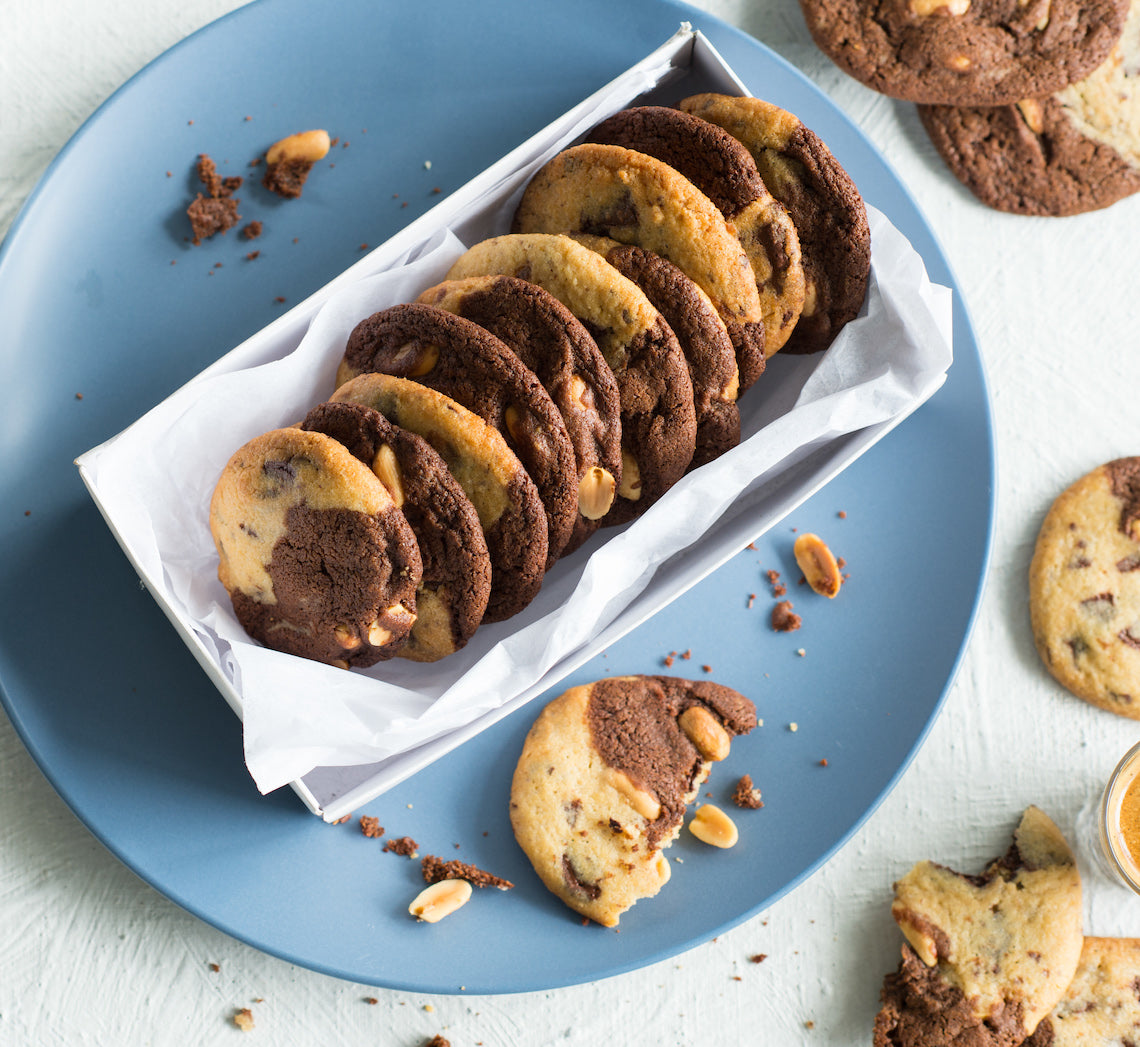
Prep 30min (+10min chilling time)
Bake 12min (per batch)Makes about 36
These clever cookies are the hybrid of a brownie and a chocolate chip cookie – dark, rich and chewy on one side and crisp, simple and familiar on the other. The perfect cookie really!
Ingredients
Chocolate chip cookie dough
125g butter, softened
110g (½ cup) granulated white sugar
55g (¼ cup, firmly packed) brown sugar
1 teaspoon natural vanilla essence or extract
1 egg, at room temperature
185g (1¼ cups) plain flour
½ teaspoon baking powder
125g good-quality dark chocolate chips or coarsely chopped chocolate (45-54% cocoa)
Salted peanut brownie dough
125g good-quality dark chocolate (45-54% cocoa), chopped
100g butter, cubed
165g (¾ cup, firmly packed) brown sugar
1 egg, at room temperature
1 teaspoon natural vanilla essence or extract
150g (1 cup) plain flour
½ teaspoon bicarbonate of soda
100g salted roasted peanuts
Method
- Preheat the oven to 180°C (160°C fan-forced). Line a large oven tray with non-stick baking paper.
- To make the Chocolate Chip Cookie Dough, use an electric mixer to beat the butter, sugar and vanilla until pale and creamy. Add the egg and beat well. Sift together the flour and baking powder, add to the butter mixture with the chopped chocolate and mix on the lowest possible speed until just evenly combined. Cover and place in the fridge while making the salted peanut brownie dough.
- To make the Salted Peanut Brownie Dough, put the dark chocolate and butter in a medium heatproof bowl over a saucepan of simmering water (make sure the base of the bowl doesn’t touch the water). Use a metal spoon to stir occasionally over low heat until just melted and smooth. Transfer to a large bowl and cool slightly. Use a balloon whisk to stir the sugar, egg and vanilla into the chocolate mixture until well combined. Sift together the flour and bicarbonate of soda, add to the chocolate mixture with the peanuts and use a wooden spoon to stir until evenly combined. Cover and place in the fridge to chill for 10 minutes or until the same consistency as the chocolate chip cookie dough.
- Take half a tablespoonful of both doughs and roll them together into a ball, keeping the different colours separate. Place on the lined tray, with the join between the two doughs running down the centre. Flatten to about 4cm in diameter and 1cm thick. Repeat to fill the tray, leaving about 5cm between the cookies.
- Bake in for 12 minutes or until the chocolate chip half is golden and cooked through and the brownie halves are still slightly soft to touch. Cool on the tray. Repeat with the remaining cookie doughs in two more batches.
Baker's Tips
- These cookies will keep in an airtight container at room temperature for up to 5 days – the longer they are kept the softer they will become.
Photography by Alan Benson.
This recipe is from Anneka's SBS Food online column, Bakeproof: Brownies.
CLICK HERE for more Bakeproof columns and recipes.
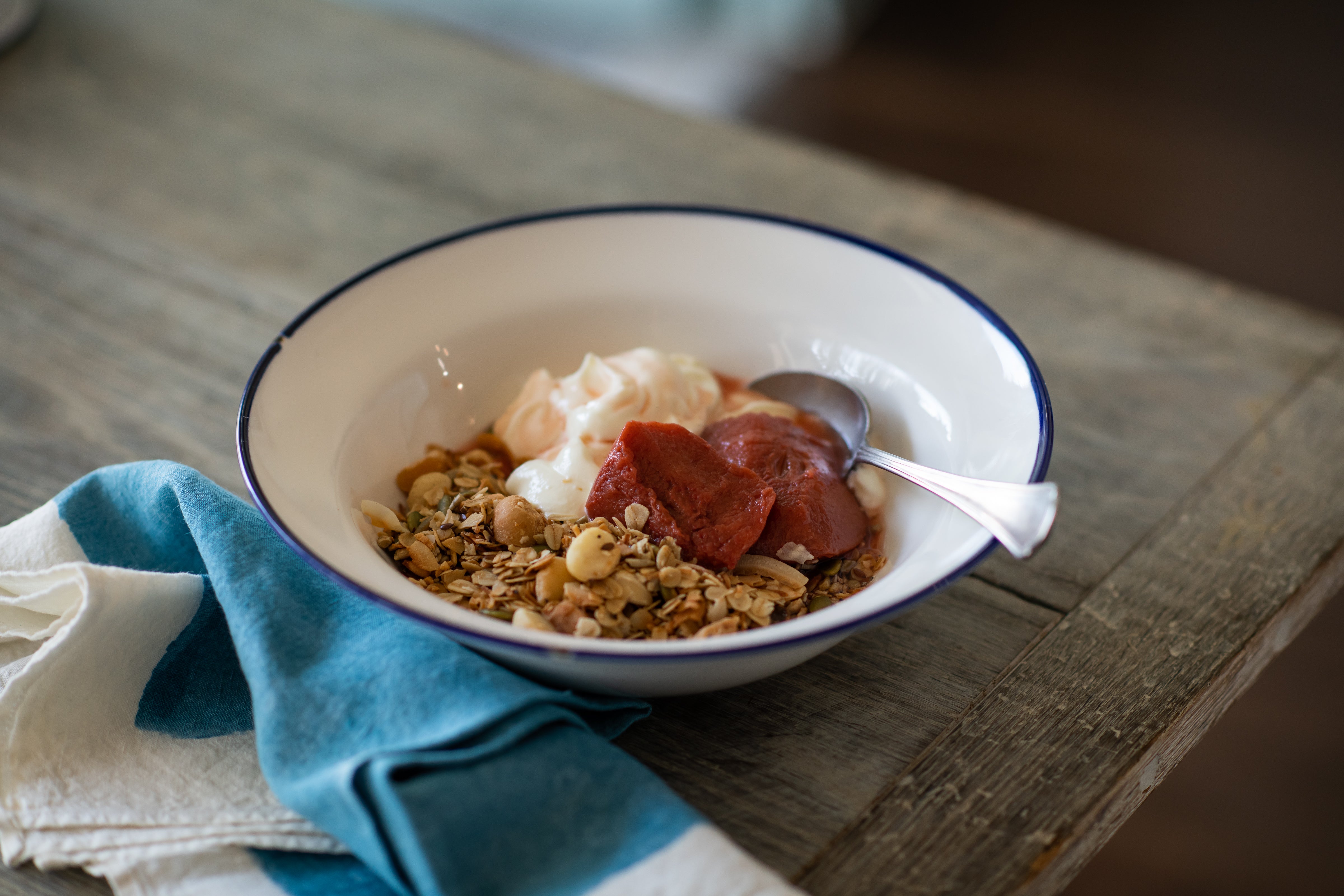
Prep 15minBake 30-40minMakes 1kg
Scrumptious and satisfying, this granola recipe is one that Make Me a Baker graduate, Sarah Taylor, serves at her cafe Six Smith in Cronulla on Sydney's southern beaches. If you would like to serve it just as Sarah does, greek-style yoghurt and seasonal fruit, such as oven-baked rhubarb, pears or apples, will make the perfect accompaniment.
Ingredients
275g rolled oats
75g sunflower seeds
75g coconut chips / flakes
75g shredded coconut
75g pepitas
25g white chia seeds
25g black chia seeds
25g poppy seeds
200g unsalted macadamias
60g maple syrup
60g almond oil
Method
- Preheat the oven to 170°C (150°C fan-forced).
- Combine all ingredients except the maple syrup and almond oil in a large bowl. Set aside.
- Heat the maple syrup and almond oil in a small saucepan over a low heat until warmed through and and combined. Pour over the rolled oats mixture and mix thoroughly until combined and evenly coated.
- Spread the oat mixture evenly over 2 medium shallow baking trays and bake in preheated oven for 30-40 minutes, stirring every 10 minutes, until golden and aromatic.
Baker's tip
- This granola will keep well in an airtight container or jar for up to 4 weeks.
$50.00/pp
more info- Products -
Learn to bake the BEST scones you have ever eaten – light, flaky and irresistible – in this fun and casual online baking class!
Scones LIVE is not currently scheduled.
If you are interested in taking part in a future class, please fill out your details below and you'll be one of the first to know when new dates are released.
I've eaten a fair few scones and even made several batches in my day, none of which compared to the calibre of the scone taught in Anneka's online Scones class. It was revelatory. In addition to Anneka's friendly and approachable style, there are comprehensive explanations, expertise and skills. I recommend this class as a way to relax and switch off from your everyday, if only to experience the very best of scones, made by your own hands.
Lee, NSW
Learn to bake the BEST scones you have ever eaten – right in your very own kitchen!
Scones is a fun and casual 1.5-hour LIVE virtual baking class where you will learn to make your own traditional scones – light, flaky and irresistible!
Anneka Manning will take you through the process step by step, sharing all of her practical tips and tricks along the way to guarantee success. You will have the ability to bake along with her as well as ask any questions that arise as you rub, mix, shape and bake your own ‘cream scones’. You will also learn how to adapt the basic recipe to create a range of different scones for any occasion.
The virtual Live Session will be supported by printable recipes and resources which will become your go-to scone baking kit. Anneka will also share a number of recipe variations so that you can use the techniques and tips learnt to create both savoury scrolls and a divine dessert.
At the end of this class, you will come away not only with new-found skills and confidence but a batch of fresh-from-the-oven warm scones ready for Sunday afternoon tea!
Dates
Scones LIVE is not currently scheduled.
If you are interested in joining a future class and would like to be notified when new dates are released, please fill in your details at the top of this page.
Cost
$50
Student numbers
We will only be accepting a limited number of bakers for this class so that Anneka can answer your baking questions during the Live Session and provide personal feedback.
The Scones LIVE class was such a joy to be part of. I'm no stranger to baking or scones but I felt like I achieved my best scones to date, even though I thought I did well prior. I really loved being part of such a wonderful group where I did not feel pressure or judgement, I was just at ease! Come as you are, you are definitely welcome at a BakeClub class.
Alicia, NSW
Who is this class suitable for?
This class is, quite simply, suitable for everyone – from absolute beginners to more experienced bakers who want to brush up on their scone-making skills. As this class is completed online, it is suitable for students from all over the world.
What will I get?
- A 1.5-hour virtual live baking demonstration (which will take place on Zoom and will be recorded) where you will learn and bake along with Anneka Manning through the process of making traditional scones
- Access to Anneka's baking experience, knowledge, tips and tricks, and the ability to ask her any questions that come up during the class
- A chance to learn surrounded (virtually) by like-minded people
- A thorough understanding of how to make traditional scones and how to apply what you’ve learnt to be able to troubleshoot in the future and ensure baking success
- Invaluable printable information sheets and recipes
- Lifetime access to the live video and course material
- Membership to BakeClub's exclusive The Kitchen Table online group to continue asking questions and share your baking
- Baking confidence, knowledge and skill to use regularly at home
Seeing Anneka make scones and explain what she is doing and being able to ask questions is so valuable – you are in the kitchen with her and learning from her years of experience. It is also great to learn and share your experience and ideas with the other participants. A fun afternoon with a delicious batch of scones to enjoy at the end!
Vanessa, South Australia
How will I get the most out of this online class?
To get the most out of this class, you need to set aside the time to attend the Live Session with Anneka and read the support material supplied beforehand. The Live Session will be recorded so it will be available to watch at any time if you are unable to attend. However, we do recommend baking along to get the most out of the class.
What if the dates don't suit me? Can I still enrol in the class?
If the date of this class doesn't work for you, you can still enrol and take part in your own time. While you may miss out on the Live Session, it will be recorded and will be available to watch when it suits you. You will have lifetime access to the video, as well as all the course material (including all of the resources and recipes).
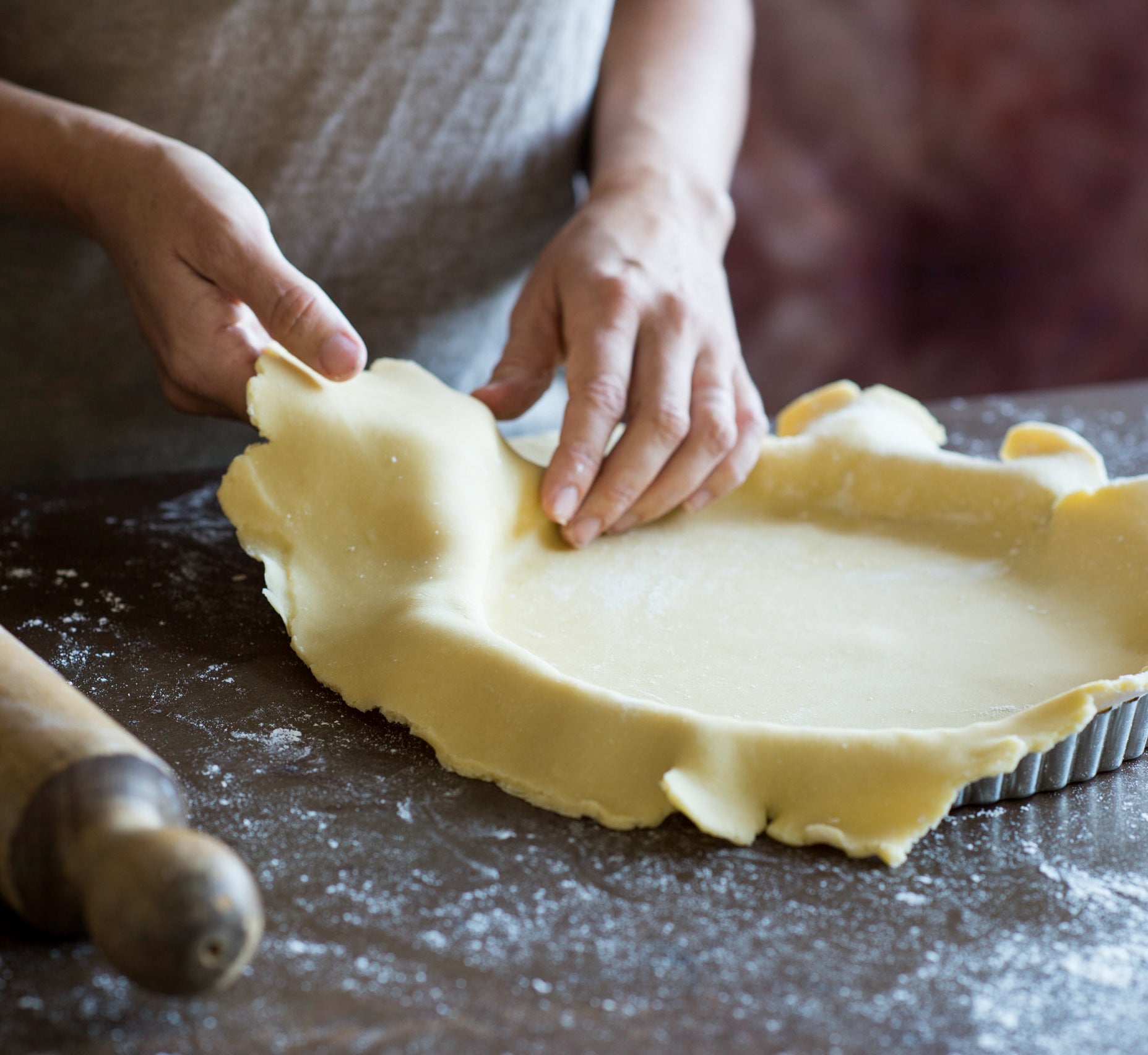
Prep 15min (+20-30min chilling time)Makes: Enough for a 23cm/9in round tart case
A really good, well-made, homemade pastry is always the secret to a fabulous pie or tart and shortcrust pastry, when you have a good recipe, is one of the simplest and quickest pastries to make. Here I have given lots of making ahead and freezing tips as well as some great variations to use in a selection of both sweet and savoury tarts and pies.
Ingredients
225g (1½ cups/8oz) plain flourGood pinch salt
150g (5¼oz) chilled unsalted butter, diced
3-3½ tablespoons (60-70ml/2½fl oz) iced water
Method
- Combine the flour and salt in a large, wide mixing bowl. Add the chilled butter. With your palms facing upwards, use your fingertips to rub in the butter until the mixture resembles breadcrumbs with some larger pieces of butter still visible.
- Sprinkle 3 tablespoons (60ml/2fl oz) of the iced water over the flour and butter mixture. Use a butter or round-ended knife in a cutting motion to mix, turning the bowl frequently, until evenly combined and the mixture starts holding together. Press a little of the mixture between your fingers – if it holds together easily, there is no need to add more water; if it doesn’t add the remaining 1⁄2 tablespoon (10ml/⅓fl oz), a teaspoon at a time, combining with the knife until it reaches the right consistency. The pastry should be soft but not sticky.
- Bring the pastry together with your hands in the bowl or turn out onto a cool bench top and then bring together. Lightly knead the pastry with your fingertips for about 5-10 seconds or until it comes together but isn’t completely smooth. Shape the pastry into a disc about 2cm/¾in thick, wrap well in plastic wrap, baking paper or beeswax wrap and place in the fridge for 20-30 minutes to rest. Use as directed.
Baker's Tips
This pastry is also enough for a 24cm/9½in square tart case; ten 6cm/2¼in or eight 8cm/3¼in) individual round tart cases; a 12cmx34.5cm/4¾inx13½in) rectangular tart case; or 24 tartlet cases (1 Tbsp/20ml/¾fl oz capacity)
Making Ahead
Keeping in the fridgeShape uncooked pastry into a disc. Wrap well in plastic wrap and keep in the fridge for up to 3 days. Stand at room temperature for about 1 hour (depending on the temperature in your kitchen) until softened slightly and pliable enough to roll easily.
Freezing uncooked pastry
Shape uncooked pastry into a disc. Wrap well in plastic wrap, then seal in a freezer bag or airtight container and freeze for up to 6 months. Transfer to the fridge to thaw completely (this will take about 1 day). Stand at room temperature for about 1 hour (depending on the weather) until softened slightly and pliable enough to roll easily.
Freezing uncooked pastry case/s
Place the pastry case, still in the tin or dish, in the freezer until frozen. Once frozen, leave the pastry in the tin or dish or remove and seal in freezer bag or an airtight container. Freeze for up to 6 months. Bake in the tin or dish directly from the freezer or transfer to the fridge to thaw completely in the tin or dish (this will take about 1 day) and then bake as directed.
Variations
- Rich Shortcrust Pastry: Increase the butter to 170g (6oz). Replace the water with 1 lightly whisked egg yolk.
- Parmesan Shortcrust Pastry: Combine 40g (½ cup/1½oz) finely grated parmesan to the flour and butter mixture just before adding the water.
- Mustard Shortcrust Pastry: Add 1½ teaspoons dry mustard powder to the flour and salt before rubbing in the butter.
- Sweet Shortcrust Pastry: Stir 2 tablespoons sifted icing sugar or caster sugar to the flour and butter mixture just before adding the water.
- Chocolate Shortcrust Pastry: Reduce the flour to 200g (1⅓cups/7oz). Sift the flour with 2 tablespoons cocoa powder and 2 tablespoons icing sugar and the salt before rubbing in the butter.
- Sweet Orange & Vanilla Shortcrust Pastry: Reduce the flour to 200g (1⅓cups/7oz). Add 2 tablespoons almond meal, 2 tablespoons caster or icing sugar and 1 teaspoon finely grated orange zest to the flour and salt before rubbing in the butter. Add 1 teaspoon natural vanilla essence or extract with the water.
This recipe is from Anneka's SBS Food online column, Bakeproof: Never-fail Shortcrust Pastry. CLICK HERE for more Bakeproof recipes.
Photography by Alan Benson.
$100.00/pp
more info- Products -
Uncover the secrets to perfect shortcrust pastry in this comprehensive and accessible self-paced online baking course!
If you are interested in this class as well as learning how to make Puff Pastry and Leavened Puff Pastry, you can book our 3 pastry classes together and save 15% with our special bundle deal!
I have avoided making shortcrust pastry because it hasn’t always worked and seemed too hit and miss. I hoped the class would give me what I need to know to get it right each time and give me confidence, and both these expectations were met! Having the [video] where we could watch Anneka ... was so valuable ... It really was like having Anneka in my kitchen – it was very comfortable and relaxed and it gave me so much confidence.
Vanessa, South Australia
Uncover the secrets to perfect shortcrust pastry – right in your very own kitchen!
Shortcrust Pastry is a fun and accessible online baking course where you will learn the art of making your own melt-in-the-mouth pastry – all from your very own kitchen.
Anneka Manning will take you through the process and share her more than 35 years of baking experience, knowledge and research, as well as all of her practical and handy tips and tricks.
The course includes a 3-hour masterclass pre-recorded video (which was previously recorded as a Live Session), which enables you to take part in this course entirely at your own pace. Not only does the video include full step-by-step instructions for making shortcrust pastry from scratch and a Quiche Lorraine, but you will have the ability to bake along in your own time and have access to all the questions that were answered during the session.
This virtual masterclass is supported by printable recipes and resources which will become your go-to shortcrust pastry kit. Along with the Quiche Lorraine recipe, Anneka also shares a number of tried-and-tested recipes including a seasonal Fruit Galette and a Roasted Pumpkin, Tomato and Oregano Tart.
At the end of this course, you will walk away with all the knowledge, skill and confidence you need to be able to bake your own delicious shortcrust pastry at home and never rely on store-bought pastry again.
Dates
Shortcrust Pastry is a self-paced course and is now open for enrolment.
Please note: The video included in this course is a pre-recorded 3-hour video of a previous Live Session.
If you're interested in joining in a future LIVE class and would like to be notified when new dates are released, please fill out your details at the bottom of this page.
This course was great! So informative and easy to follow along. I can now make shortcrust pastry and bake some amazing pies and tarts – all delicious!
Caroline, USA
Cost
$100
Who is this class suitable for?
This class is, quite simply, suitable for everyone – from absolute beginners to more experienced bakers who want to brush up on their pastry-making skills. As this class is completed online, it is suitable for students from all over the world.
What will I get?
- A 3-hour pre-recorded masterclass video where you can bake along with Anneka Manning and learn how to make your own shortcrust pastry and a Quiche Lorraine
- Membership to BakeClub's exclusive The Kitchen Table online group
- Access to Anneka's 35+ years of baking experience and knowledge through The Kitchen Table and the ability to ask any baking-related questions
- A thorough understanding of the shortcrust pastry process and how to apply what you’ve learnt to be able to troubleshoot in the future and ensure baking success
- Invaluable printable information sheets and recipes
- Lifetime access to the live video and course material
- A chance to (virtually) meet like-minded people and share your baking with The Kitchen Table online group
- Baking confidence, knowledge and skill to use regularly at home
How does a self-paced course work?
This online course is completely self-guided. Upon enrolment, you will gain access to the course content which you can work through at your own pace. You can log on whenever it is convenient for you and watch the video and bake the recipes entirely in your own time. You will have lifetime access to all the recipes, videos and printable information sheets.
There is the option to connect with Anneka and other bakers via Facebook through BakeClub's exclusive The Kitchen Table membership groups. This way you can share your experience and support each other as your confidence and skills grow.
Once you learn the basics and understand that you can fix problems along the way, it takes the fear out of making shortcrust. I understand what I am doing now and feel more confident. I loved every minute of the course... And I can make pastry now!
Gail, Sydney
Watch the video below for a sneak peek into one of our Live Sessions...
If you are interested in joining a future LIVE class, please fill out your details below and we'll be in touch when new dates are released.
$150.00/pp
more info- Products -
Sourdough is an in-depth, self-paced online course where you will learn everything there is to know about making and baking your own artisan sourdough bread.
From start to finish this course is all you need to know about sourdough bread making and you can do it in your own time! I particularly like the way you explain the science behind cooking as it helps me understand each step of the process better and where I might need to make adjustments ... All of it was wonderful!
Maria Hickey, Victoria
Discover everything you need to know about making your own sourdough – in your own time!
Sourdough is an in-depth, self-paced online course where you will learn everything there is to know about making and baking your own artisan sourdough bread – in your own time, at your own pace – all from your own home kitchen!
Made up of a combination of demonstration videos, printable recipes and invaluable information sheets that you can study at your own pace, this online course will take you through the entire process from making and maintaining your own sourdough starter through to proving, kneading, shaping, baking and even storing your bread.
Throughout the course, Anneka Manning shares her more than 30 years of baking experience, knowledge and research, as well as all of her practical and handy tips and tricks.
At the end of this course, you will walk away with all the knowledge, skill and confidence you need to be able to bake your own delicious sourdough bread at home.
How to enrol
Sourdough is now open for enrolment.
I really enjoyed the journey of making sourdough from the starter, to the different feedings and the proving process. It has given me a different appreciation of this delicious bread! Anneka has a wealth of baking knowledge. As always, so professional and fun! I got all I expected from this course.
Corina Benjamin, Sydney
Cost
$150
Who is this course suitable for?
This course is, quite simply, suitable for everyone, but it is aimed at intermediate to experienced bakers. As this course is completed online, it is suitable for students from all over the world.
What will I get?
- Four downloadable modules which will take you through the complete process of making your own sourdough
- A thorough understanding of the sourdough process and how to apply what you’ve learnt to be able to troubleshoot in the future and ensure baking success
- Membership to BakeClub's exclusive The Kitchen Table online group
- Invaluable printable information sheets and recipes
- Baking confidence, knowledge and skill to use regularly at home – and the inspiration to get into the kitchen and get baking!
What will I learn?
- What a sourdough starter is
- How to make your own sourdough starter
- How to feed, maintain, store and get the most from your sourdough starter
- What a levain or pre-frement is
- Key ingredients and equipment needed to make great sourdough bread
- What is the most ideal way to knead and prove your sourdough
- Using proving baskets and how to shape your sourdough without them
- The secret to a crunchy crust and chewy texture (like the artisan ones you buy!)
I would recommend this course as an excellent introduction to baking sourdough bread with experience that could not be gleaned from just reading a recipe.
Sheila Zanyk, Canada
How does a self-paced course work?
This online course is completely self-guided. Upon enrolment, you will gain access to the course content which you can work through at your own pace. You can log on whenever it is convenient for you and complete the modules one day at a time.
You can take as long as you need to complete the course – it's up to you how quickly you want to work through the content. You will have lifetime access to all the videos, recipes and printable information sheets so you can dip in and out of it whenever it suits you.
There is the option to connect with other bakers via Facebook through BakeClub's exclusive The Kitchen Table membership group and via Instagram using #bakeschoolsourdough. This way you can share your experience and support each other as your confidence and skills grow.
Can I use my own sourdough starter if I already have one?
You are more than welcome to use your own starter if you already have one but we do recommend that you use a sourdough starter that is 100% hydration. A 100% hydration starter is made from, and fed with, equal quantities (by weight) of both flour and water, or 1 part flour and 1 part water (for example, 125g of starter is fed with 125g water and 125g flour).
So, is Sourdough for me?
- Would you like to master the technique of making your own sourdough bread from scratch?
- Would you love to be able to bake artisan-style bread at home?
- Would you like to be guided and inspired by Anneka's 30+ years of baking experience in your own kitchen?
- Do you have more time on your hands at the moment and keen to learn a new skill?
If any of these sound like you, then this course is the one for you!
I have tried making sourdough in the past, but never had consistent results. This course is a great way to start your sourdough baking journey and gives you a solid foundation to work from.
Su Shearer, Victoria
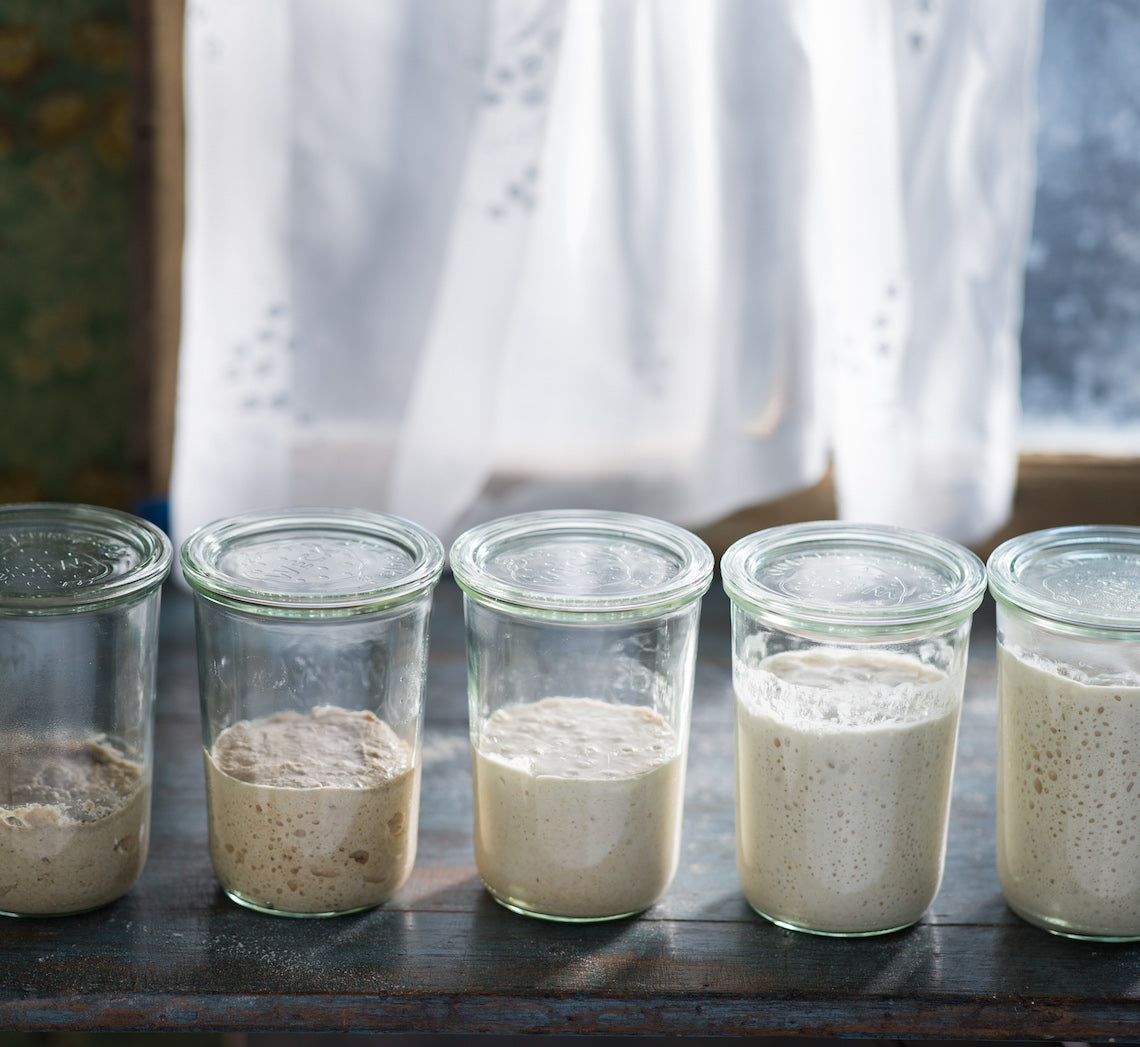
Prep 5 days
A practical, step-by-step guide with tips, tricks and timelines to making your own sourdough starter and baking with it.
This method is logical and simplified for beginner bakers to follow (and expert bakers to hone). While the process of making this starter is a little lengthy (at least 5 days) it isn’t difficult, if you follow the steps and take note of my tips.
The detailed steps are below, but here is a nifty quick reference to keep you on track:
Day 0
125g flour + 125g water, stand for 48 hours
↓ ↓
Day 2
1st feeding: 125g starter + 125g flour + 125g water, stand for 24 hours
↓ ↓
Day 3
2nd feeding: 125g starter + 125g flour + 125g water, stand for 24 hours
↓ ↓
Day 4
3rd feeding: 125g starter + 125g flour + 125g water, stand until doubled in size (8—24 hours)
↓ ↓
Day 5
If not doubled in size, feed every 12 hours until doubled in 8 hours or less
↓ ↓
Use 'active' starter OR store at room temperature or in fridge.
Sourdough starter method - Day 0
A young starter is quite sensitive so when establishing your sourdough starter it is important to follow the process (measuring the flour and water accurately, feeding at the suggested times, etc.) But once mature and strong, it will have more flexibility and will be more resilient to changes so don’t worry too much if you occasionally miss a feeding by a day or so or if your quantities are slightly out - just get back on track as soon as you can and your starter will bounce back.
Ingredients
Starter
125g organic wholemeal flour (see Baker’s Tips #1 and Variations)
125g bottled water, at room temperature (see Baker’s Tips #2 and #3)
To feed the starter
unbleached organic plain flour (see Baker’s Tips #1)
bottled water, at room temperature
Method
Day 0
- Place the wholemeal flour and water in a medium bowl and stir until well combined.
- Weigh a clean, dry jar with a lid that you are going to store your sourdough starter in and note the weight down (see Baker’s Tips #4).
- Transfer the flour mixture to the jar, seal and set aside in a warm draught-free place (see Baker’s Tips #5) for 48 hours (see Baker’s Tips #6).
After 12 hours (see images, jar 1, from left), there won’t be much change in your mixture although a few bubbles may start to appear through the side of the jar.
After 48 hours (see images, jar 2, from left), the starter may have risen just a little and a dark skin would have formed. There may be a few bubbles on the surface and also noticeable through the side of the jar – but not always. Proceed to the first feeding.
If you don't see these signs, set aside for another 24 hours – if there are no signs of activity by then, just continue with the first feeding. The aroma will be quite unpleasant.
Variations
Rye sourdough starter: replace the wholemeal flour with 100g rye flour (and feed with unbleached organic plain flour).White sourdough starter: replace the wholemeal flour with 125g unbleached plain flour (and feed with unbleached organic plain flour).
Baker's Tips
#1. In my experience, I’ve had the best results with starting a sourdough starter with organic wholemeal flour and then switching to unbleached organic plain flour for feeding until it is established. Once mature, you can then just switch to regular plain flour or bread flour for feeding, or even occasionally feed it with wholemeal flour again to add a little ‘nuttiness’ to its flavour.
#2. Use bottled water (or water that is filtered and has been allowed to stand uncovered for at least 4 hours for the chlorine to dissipate) to give your sourdough starter the best possible chance of success.
#3. It’s a good idea to embrace measuring both your flour and water in grams when making and maintaining your sourdough starter. It is the most accurate way of measuring and will give you the best possible chance of success.
#4. A sourdough starter can be mixed and kept in a non-reactive container such as a glass jar. Look for one that has straight sides and a reasonable sized mouth to make mixing easy. This starter recipe will need a jar that has a capacity of at least 1 litre (4 cups) and, before making your starter, ensure that it is very clean and dry. It’s a good idea to note the weight of your jar so that it is easy to calculate how much sourdough starter you need to remove and discard every time you feed it.
#5. The ideal temperature for proving sourdough starter is between 21°C-23.5°C (70ºF-74ºF). Don’t be tempted to keep the starter at higher temperatures to accelerate the process as it won’t necessarily mean you will get a better result. Higher temperatures can encourage more ‘bad’ bacteria to grow than the ‘good’ ones, which will ultimately ruin the starter. If your kitchen is cold, I find placing it under the stove rangehood with the light on or on top of the fridge gives a warm (but not too warm), consistent temperature.
#6. After each feeding, it’s a good idea to mark the side of the jar with tape (or an elastic band) so you can see how much it grows in the specified time.
Sourdough starter method - Day 2
First feeding after 48 hours
- Remove and discard all but 125g of the sourdough starter from the jar.
- Add 125g plain flour and 125g water to the jar and stir well to combine.
- Use a clean spatula to scrape the sides of the jar down to clean (see Baker’s Tips #7).
- Seal the jar and set aside in a warm, draught-free place for 24 hours.
After the first feeding and rise, the starter would have risen slightly (up to 50%) (see images, jar 3, from left) and random bubbles will be visible on the surface as well as through the side of the jar indicating the wild yeast is active and starting the multiply.
Baker's Tips
#7. Make sure you scrape down the side of the jar after every feed – this will make it easier to see how much the starter has risen each time.
Sourdough starter method - Day 3
Second feeding after 24 hours
- Remove and discard all but 125g of the sourdough starter from the jar.
- Add 125g plain flour and 125g water to the jar and stir well to combine.
- Use a clean spatula to scrape the sides of the jar down to clean.
- Seal the jar and set aside in a warm, draught-free place for 24 hours.
After the second feeding and rise there will be more visible bubbles but they will be smaller and more uniform (see images, jar 4, from left). The aroma will be less pungent and a little sweeter.
Sourdough starter method - Day 4
Third feeding after 24 hours
- Remove and discard all but 125g of the sourdough starter from the jar.
- Add 125 g plain flour and 125g water to the jar and stir well to combine.
- Use a clean spatula to scrape the sides of the jar down to clean.
- Seal the jar and set aside in a warm, draught-free place until doubled in size (8-24 hours, depending on the strength of your sourdough).
Sourdough starter method - Day 5
Depending on the strength of your sourdough and how quickly it ferments it may double in size in less than 24 hours. You may also notice that once it doubles it starts to lose volume and falls back on itself indicating that it needs regular feeding from this point.
If your starter has not doubled in 24 hours or less, continue the discarding and feeding process every 12 hours until it has the ability to double in size in 8 hours or less. When it does, it is now "active" and ready to use, or store in the fridge to be used at a later date (see Baker’s Tips #8).
Baker's Tips
#8. A young starter is quite sensitive so when establishing your sourdough starter it is important to follow the process (measuring the flour and water accurately, feeding at the suggested times, etc.) But once mature and strong, it will have more flexibility and will be more resilient to changes so don’t worry too much if you occasionally miss a feeding by a day or so or if your quantities are slightly out - just get back on track as soon as you can and your starter will bounce back.
What's that smell? Aroma changes in sourdough starter
When making and establishing a sourdough starter you will notice that the aromas it gives off change quite considerably from one day to the next. This is because the bacteria present is changing and ‘settling’.
To start, in the first day or so, it can smell quite foul but will mellow with subsequent feedings and over time the smell will become slightly tangy and sweet and then more sour. You will also notice once the sourdough starter has matured and is more stable, the aroma will become more consistent too.
The aroma will also change depending on where it is in the feeding cycle once established, mature and healthy; it will have a slightly sweet scent when first fed, and will become more sour as it stands and ripens ready for use.
Sourdough starters can be unpredictable
Remember all sourdough starters are different. There are so many things that can vary while making a sourdough starter (including the type of wild yeast and bacteria present, the temperature the starter is held at, etc.) and ultimately this will affect how long it takes for your starter to become mature.
Sometimes, a starter may seem to be on the right track and then, for whatever reason, it doesn’t progress at all. If yours doesn’t reflect the exact description above, don’t lose heart, be patient and keep repeating the feeding process every 12 hours until your starter reflects the Day 5 description before you move onto maintaining, storing and using it.
How to use your sourdough starter in your baking
To make sure your sourdough starter is strong and 'active' enough to use in baking, you will need to feed, maintain and store it. Click here to find out how.
Once your starter is ready to use, this Basic sourdough bread recipe is a well-tested recipe to begin your sourdough baking.
This recipe is part of Anneka's SBS Food Bakeproof: Sourdough online column. For more Bakeproof columns and recipes, click here.
Photography by Alan Benson.
$100.00/pp
more info- Products -
Learn to whip up your own light and fluffy sponge cakes in this fun and informative self-paced online baking course!
Sponges have always terrified me. I knew there was a method that I was not doing, so was great to get this info. This is a great online course ... Loved it!
Cath, Perth
Discover the secrets to super light sponges – right in your very own kitchen!
Sponges is a fun and informative online baking course that will have you whipping up your own light and fluffy sponge cakes – all from your very own kitchen!
Guiding you through the process will be Anneka Manning, ready to share her more than 35 years of baking experience, knowledge and research, as well as her practical and handy tips and tricks.
The course includes a 2.5-hour masterclass pre-recorded video (which was previously recorded as a Live Session), which enables you to take part in this course entirely at your own pace. Not only does the video include full step-by-step instructions for making a Classic Hot Milk Sponge, but you will have the ability to bake along in your own time and have access to all the questions that were answered during the session.
This virtual masterclass is supported by printable recipes and resources, as well as individual technique videos, which will teach you everything you need to know to conquer your fear of these gorgeous, classic cakes at home and become your go-to sponge baking kit.
At the end of this class, you will walk away with fail-safe recipes, techniques and confidence you need to bake a gorgeous sponge whenever the mood takes you!
Dates
Sponges is a self-paced course and is now open for enrolment.
Please note: The video included in this course is a pre-recorded 2.5-hour video of a previous Live Session.
If you're interested in joining in a future LIVE class and would like to be notified when new dates are released, please fill out your details at the bottom of this page.
Give it a go! Anneka will have you making a sponge in no time.
Alison, Melbourne
Cost
$100
Who is this course suitable for?
This course is, quite simply, suitable for everyone. As this course is completed online, it is available to students from all over the world.
What will I get?
- A 2.5-hour Live Session where you can bake along with Anneka Manning and learn how to make a Classic Hot Milk Sponge
- Membership to BakeClub's exclusive The Kitchen Table online group
- Access to Anneka's 35+ years of baking experience and knowledge through The Kitchen Table and the ability to ask any baking-related questions
- A thorough understanding of how to make sponges and how to apply what you’ve learnt to be able to troubleshoot in the future and ensure baking success
- Invaluable printable information sheets, recipes and technique videos
- Lifetime access to the video and course material
- A chance to (virtually) meet like-minded people and share your baking with The Kitchen Table online group
- Baking confidence, knowledge and skill to use regularly at home
What will I learn?
This class covers the various mixing methods and techniques used when making sponge cakes and includes the following recipes:
- Classic Hot Milk Sponge
- Raspberry Swiss Roll
- Powder Puffs
- Lemon Chiffon Cake
- Sponge Fingers
- Coffee & Almond Genoise (Gateau Moka)
- Elderflower Gin Sponge
Included are also Anneka's top tips for beautiful sponges, how to remove sponges from cake tins, how to roll a Swiss Roll, and loads of clever ideas on how to embellish your sponge cakes.
How does a self-paced course work?
This online course is completely self-guided. Upon enrolment, you will gain access to the course content which you can work through at your own pace. You can log on whenever it is convenient for you and watch the video and bake the recipes entirely in your own time. You will have lifetime access to all the recipes, videos and printable information sheets.
There is the option to connect with Anneka and other bakers via Facebook through BakeClub's exclusive The Kitchen Table membership groups. This way you can share your experience and support each other as your confidence and skills grow.

